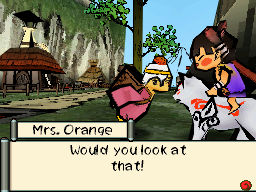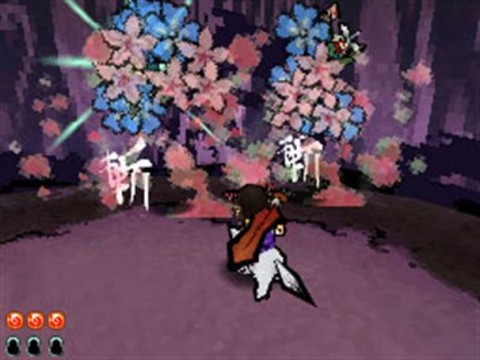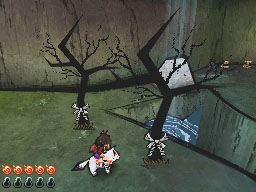Graphics, story, gameplay, characters, music and control
Slow down, frequency of loading
If you are even remotely interested in Ōkamiden, or played the original, stop reading this review right now and go buy it. I can promise you that you won’t be disappointed with what you get, and it will probably end up becoming, if not your favorite DS game ever, one of your top three. Strong words, I know, but trust me on this one.
Ōkamiden is the sequel to Ōkami, Capcom’s critically acclaimed action adventure title of 2006. First released on PlayStation 2 and later ported to Wii, it detailed the struggle of the sun god Amaterasu against an evil that was plaguing ancient Japan. Amaterasu had the help of the Celestial Brush, a paintbrush that allowed the god to alter her surroundings, from making the sun rise to cutting trees (and enemies) down. The Celestial Brush worked particularly well on Wii, as motion controls made using the brush a cinch, but it is even easier on DS thanks to the touch screen.
Ōkami was praised for its use of Japanese mythology and its beautiful art style. Many comparisons were made between it and the Zelda series, with some even going as far as to say that Ōkami was superior. It has been nearly five years since Ōkami was first released, and we finally have a sequel, and what a sequel it is. While I recommend that you play the original first, you don’t need to, as all of those characters and the events of the first game are revealed in the sequel.

Ōkamiden takes place nine months after the events of the first title, and chronicles the adventures of Chibiterasu and his friend Kuni as they once more set out to save Nippon from the forces of evil. Many familiar faces from the first title return, along with a large number of original characters and areas. Each character has a unique personality, and you will quickly grow attached to many of them. Whether it is one character suffering from a disease, or another that truly feels alone, you care about what happens to them and will do whatever it takes to save them. I could be wrong, but I doubt you’ve played a game as emotional as Ōkamiden on your DS. The characters don’t talk, instead making noises reminiscent of the Banjo-Kazooie games, and that’s not a bad thing. Any returning character from the first game has the same voice, so you won’t have to worry about any inconsistencies.
Music is another area where Ōkamiden excels. Much of the music comes from the original and sounds just as good on DS. The music fits the game perfectly, whether it is during a battle or running through a field. The music isn’t there for nothing, as it ties together the emotions that the game will pull from you during your adventure. You’ll have a great sense of what is going on from the music alone, and when it is combined with everything else it’s amazing.
The graphics of Ōkamiden are easily some of the best on the system, hands down. Despite the drop in power from PS2 to DS, Capcom has managed to not lose any of the charm or style from the original. While you’re not busy being overwhelmed by what’s happening in-game, the cutscenes will surely knock you out. They can be a bit choppy at times, but much more often than not you’ll be smiling in amazement over what you’re seeing. Remember the cutscenes that showed in the original that played after you revived a guardian sapling? They’re back and still as impressive as ever. Each of the returning areas are detailed in fantastic, colorful 3D. Many areas are right out of the first title, but that’s to be expected since they happen in the same world. But don’t worry, there are plenty of new areas to enjoy as well.
Loading spots are noticeable in the game due to the complex world design. Entrances and exits in Ōkamiden‘s areas are walled off by a blue shield you must pass through before you can reach the next location. When you walk through one of these shields, the screen will go dark for a few seconds, but the music will continue to play to mask the loading. Sometimes, you may have to go through two of these shields nearly one after another to get to a new area, while in other cases you’ll have to traverse a large field before needing to load a new one.
This is a very minor inconvenience but never feels bothersome. Ōkamiden pushes the DS like no other title before it, so it needs to load an insane amount of data. After all, Capcom is trying to accomplish on DS what was done on PS2, and some concessions had to be made. Unfortunately, because of everything that Capcom was trying to do, there are some areas of the game where slowdowns occur. There are so many things going on in the title at once that DS simply can’t handle the strain of numerous buildings, people and Chibi. It isn’t really noticeable until about halfway through the game and is for the most part confined to one area.
In the overworld, you’ll control Chibi with the control pad in full 3D, just as you did in Ōkami. You can run in every direction, jump, and attack all in 3D. Movement may be a little strange at first, as the control pad can’t give the same amount of finesse as with an analog stick, but you’ll get used to it. If you have a 3DS, it is even easier to control Chibi though it’s still not analog.
To use the Celestial Brush, you’ll either hold or tap L, then draw to your heart’s content. As stated earlier, the touch screen makes it even easier to use the brush than ever before, but as with Ōkami on Wii, sometimes you still need to be perfect. For example, if you need to follow a character’s attack with the slash brush ability, you need to draw your line exactly on top of their attack. If you miss or leave the line by even a little, there’s a good chance you’ll fail and have to start again. However, situations like this aren’t too common, and you’ll be able to get away with deformed circles for your trees and cherry bombs.

All of the Celestial Brush techniques from Ōkami make their return in the sequel, with the addition of some new ones. For instance, the guide ability will allow Chibi to direct Nagi on where to go next, while you may have to press a switch as he is moving. It’s something we’ve seen in Phantom Hourglass, but is a welcome feature to Chibi’s arsenal. The camera in Ōkamiden is yet another thing that this game excels at. It will follow you through villages and along winding roads. It is so good that in some areas all you’ll have to do is hold up to move, and the camera will do the rest.
As you move around the gigantic overworld, you will inevitably come into contact with demons. As a matter of fact, the first thing you do in Ōkamiden is fight a bunch of demons. As with Ōkami, once you enter combat, the screen will shift to Chibi inside a circular area of land surrounded by darkness. The A button dodges, and the B button makes Chibi jump. The Y button is the one that you will be using most of the time, as it makes Chibi attack. Depending on what weapons Chibi has, your attacks will do different things. If Chibi has a reflector equipped, you’ll be able to perform attacks at a decent speed, strength and rate. If you have a sword, your attacks will be slower, but you can hold down the Y button to use a charged-up attack. Lastly, beads are the weakest weapon, but also the fastest. Repeatedly pressing Y will result in the bead attacks chaining together for a chunk of damage.
While you’re in battle, you’ll also be getting help from Nagi. After you’ve performed a combo of a certain number of hits, Nagi will jump off of Chibi and begin to assault the enemies with his sword. It’s important to let this happen as it will factor in to your rank for each battle. The same battle system from Ōkami returns and grades you on how much damage you did, how fast you won, and your partner’s attacks. Ratings range from seeds to a fully bloomed cherry blossom. The higher rank will end up getting you more yen, which you can use to put towards a wide variety of items and skills. Nothing has been lost in the combat system from the transition, and it is better if anything. Being able to use the touch screen means that you can slice your enemies up with the Celestial Brush in no time during battle, and collect a number of demon parts.

Demon parts are items that you will need to upgrade your weapons throughout the game. Each enemy has a specific finishing move that will cause it to drop a part. At the beginning of the game, the power slash is the only brush technique you’ll need, but by the end the finishing moves aren’t so clear so you’ll need to fight some enemies multiple times before you know what attack to kill them with. There are always plenty of enemies to fight, thus you’ll never run out of money. One thing you may run out of, however, is ink.
Since Chibi isn’t a fully developed god yet, his mastery of the Celestial Brush isn’t up to the level of his mother. This means that Chibi has a time limit of how long he can use the brush, and as in Ōkami, the more brush attacks and techniques you use, the less ink you have. Your health and ink are located on the bottom left area of the screen, with the white circles (solar units) corresponding to your health and the black pots to your ink. You can buy items to refill both of them on your journey, but ultimately you’ll want to increase them. This is where praise comes in. You will earn a certain amount of praise when you purify an area of land or when you help a person in need. This praise is what ultimately allows you to level up. There is a praise meter on the lower screen that will keep track of how close you are to raising a level. When your praise reaches the end of the bar, you’ll get a new solar unit of energy, ink pot, or even both. As you progress through the game, you’ll need more and more ink and health to make it through the bosses.
The bosses in Ōkamiden are enemies of gigantic proportions, and each battle is unique and memorable. Each boss, like each character, has a personality, and even reasons for their actions. Bosses are often many times the size of Chibi and are some of the best parts of the game. You’ll have to find each bosses’ weakness to give yourself a fighting chance. Each boss also plays a role in the story, and never feels unnecessary. Story is yet another area that Ōkamiden shines in, and you’d expect that if you’d played the original.
The size and detail of the title’s story just isn’t something that you would traditionally find in a handheld game. It is exceptionally deep, and has numerous twists, all while tugging at you emotionally. The depiction and use of figures from classical Japan is as staggering as the game’s scale. I don’t want to give anything away, but this is one game that you won’t soon forget. It will take you more than 20 hours to beat and there are plenty of things to do in addition to the main story.
When we did our “Best of DS” segment a few weeks ago, I didn’t really know what my favorite DS title was. I ultimately chose Mario Kart DS because that was the title I had played the most. There was no DS game that I owned (and I own a lot of them), that I could point to and say, “this is the best game on the system.” Or at least that was until now. After playing Ōkamiden I don’t even need a moment to think about what I think is the best on DS. No game on DS has the graphics, art, gameplay, and story that Ōkamiden does.
When you look at a Nintendo console, it is usually Nintendo that has the best game on the system, but not here. Capcom has successfully made a title that bests all of Nintendo’s own offerings on the console, and I look forward to seeing another entry in this fantastic series. This isn’t just the best DS game ever, this may be one of the best handheld games ever. Capcom successfully took a concept from a home console and applied it to a portable one. I wouldn’t have thought it possible, especially not on DS, but Capcom proved me wrong. Do yourselves a favor and play this game.




 ShareThis
ShareThis







I’ll never forget, when X-play first reviewed the original Okami, Morgan Webb’s comment about the painting was,
“Take that, Nintendo DS!”